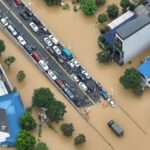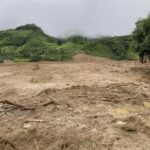On September 9, 2024, the Disaster Risk Reduction Partnership held an emergency meeting to share information about a recent typhoon, conduct a rapid assessment of the damage it caused, and develop a plan to mobilize international resources for disaster relief.
The meeting was chaired by the Partnership’s co-chairs: Mr. Nguyen Hoang Hiep, Vice Minister of Agriculture and Rural Development, and Ms. Pauline Fatima Tamesis, UN Resident Coordinator in Vietnam.

The meeting was attended by representatives from various international organizations in Vietnam, including FAO, UNDP, UNICEF, UN Women, WHO, USAID, the United Nations Population Fund, HIS, and ActionAid, as well as embassies from the UK, Switzerland, Canada, Japan, and Australia.
FOOD AND SHELTER ASSISTANCE NEEDED
In his opening remarks, Vice Minister Nguyen Hoang Hiep expressed his concerns about the typhoon’s impact: “Last year, at a workshop to share information on 2023 activities and plan for 2024, I shared my apprehension about the Year of the Dragon. In the history of natural disasters in Vietnam, some Dragon years have been painful. For example, in 1904, a historic flood in the Gò Công area and several provinces of Southern Vietnam at that time claimed the lives of 5,000 people. In 1964, a historic flood in Quảng Nam Province took nearly 10,000 lives, washed away 1,200 homes, and caused extensive damage to thousands of hectares of agricultural land.”

Mr. Hiep noted that the areas affected by the typhoon in Vietnam had relatively good infrastructure, and the local authorities and people were well-prepared to cope with the storm, minimizing damage and keeping casualties at a low level.
“Today, we are here to share information about relief efforts and coordinate timely and effective support for the affected areas,” he continued. “I appeal to all participants to join hands in providing assistance to help stabilize the lives of the affected people, including repairing houses, ensuring environmental sanitation, disease prevention, and providing food, with a particular focus on vulnerable groups such as pregnant women, children, the poor, the elderly, and people with disabilities.”
“We will continue to work closely together to assess the situation, mobilize resources, and provide essential support to the affected provinces and people.”
Ms. Pauline Fatima Tamesis, UN Resident Coordinator in Vietnam, and Co-chair of the Disaster Risk Reduction Partnership
The Vice Minister expressed his gratitude for the emergency relief supplies and cash assistance provided by international organizations and countries, emphasizing that support for recovery efforts, such as house repairs, livelihood restoration, and social protection, would be even more valuable in the coming days.
Ms. Pauline Fatima Tamesis, UN Resident Coordinator in Vietnam and Co-chair of the Disaster Risk Reduction Partnership, expressed her deep concern for the people of Vietnam affected by Typhoon Yagi. “Even here in Hanoi, we have witnessed the storm’s immense power, with strong winds, heavy rainfall, and significant damage. I can only imagine the situation in the coastal provinces, where the strong winds have caused immense destruction, and in the northern mountainous regions, where heavy rains, floods, and landslides continue to threaten local communities, especially ethnic minority groups,” she said.

Ms. Tamesis assured the Vietnamese government and the affected communities of the UN’s support during this challenging time. She committed to working closely with her partners to provide assistance to the most affected areas, prioritizing support for the most vulnerable groups, including women, children, and people with disabilities, to ensure they receive the protection and assistance they need.
“The UN recognizes the importance of aligning our responses with the government’s priorities and the needs of the affected communities,” she added.
DEVASTATING LOSSES AND DAMAGE
According to a report by the Department of Dyke and Flood Control, as of September 9, 2024, the northern region and Thanh Hoa province experienced heavy to very heavy rainfall due to the typhoon, with total rainfall ranging from 200-300mm. Some stations recorded extremely high rainfall, such as Vàng Danh in Quang Ninh province (346mm), Phủ Dực in Thai Binh province (446mm), Kỳ Sơn in Hoa Binh province (387mm), Thượng Cát in Hanoi (271mm), Nậm Xây Luông in Lao Cai province (712mm), Pú Dảnh in Son La province (549mm), Phình Hồ in Yen Bai province (476mm), and Yên Đổ in Thai Nguyen province (531mm).
As of 7:00 am on September 9, 2024, the typhoon had claimed 26 lives, including 9 direct deaths from the storm, 12 from landslides and flash floods, and 5 from flooding. The breakdown of casualties by province is as follows: Lao Cai (6), Quang Ninh (6, including 1 soldier from the 513th Brigade, Army Corps 3, and 1 police officer from the Quang Ninh prison), Hai Phong (2), Hai Duong (1), Hanoi (1), Hoa Binh (4), Yen Bai (1), Lang Son (2), Bac Giang (1), and Tuyen Quang (2). In addition, 247 people were injured due to the storm.

In terms of agricultural damage, 113,593 hectares of rice were flooded and damaged (Hai Phong 7,005 ha, Thai Binh 18,000 ha, Hanoi 15,563 ha, Hung Yen 12,119 ha, Hai Duong 18,500 ha, Ha Nam 11,220 ha, Lang Son 3,688 ha, Bac Giang 4,822 ha, Bac Ninh 9,601 ha, Vinh Phuc 6,000 ha, etc.). Additionally, 22,047 hectares of crops were flooded (Hai Phong 1,600 ha, Nam Dinh 2,500 ha, Thai Binh 3,345 ha, Hanoi 1,205 ha, Bac Ninh 2,293 ha, Hai Duong 2,900 ha, Hoa Binh 4,193 ha, Lang Son 1,136 ha, etc.). The storm also damaged 6,887 hectares of fruit trees (Phòng 1,650 ha, Thai Binh 1,385 ha, Hung Yen 1,841 ha, Hai Duong 900 ha, Nghe An 798 ha, etc.). In aquaculture, over 1,500 fish cages were washed away, and 79 livestock and 190,131 poultry were lost.
Across the northern region, 121,668 trees were uprooted or fell, with the highest numbers in Hai Duong (40,000 trees), Hanoi (24,807 trees), Hung Yen (9,036 trees), and Hai Phong (6,059 trees).
In terms of infrastructure, 25 boats of various types sank at their moorings in Quang Ninh province. Quang Ninh, Hai Phong, Thai Binh, Hai Duong, and Hanoi experienced widespread power outages and communication disruptions. The prolonged duration of the storm and the strong winds and gusts caused damage to 9,851 houses, power lines, and communication infrastructure. Many shops, offices, and schools had their roofs blown off, and numerous advertising boards, telecommunication poles, and mobile transmission stations were toppled.

According to a report by the Department of Agriculture and Rural Development of Thai Nguyen province, heavy rains after the typhoon have caused deep flooding in many areas. The affected areas include 17 wards in Thai Nguyen city, 10 communes in Phu Luong district, 1 commune in Dong Hy district, 1 ward in Song Cong city, 23 communes in Dinh Hoa district, and 2 wards in Pho Yen city.
Regarding housing, 1,985 households had to be evacuated immediately, and 63 houses were unroofed. The storm also affected 13 schools and damaged 3,019.7 hectares of rice and crops. Additionally, 29,000 chickens and 150 pigs had to be relocated to safer grounds.
In terms of infrastructure, there were 25 landslides, 6 broken cable suspension poles, and damage to some terminal equipment and a transformer. Many roads were also damaged by floods and landslides.
The provinces of Yen Bai, Thai Nguyen, Bac Giang, and Lao Cai are currently implementing measures to respond to floods and evacuate people from flooded and low-lying areas to ensure the safety and security of their citizens.
The Sweet Success of Vietnam’s Sugarcane Industry: Climbing to the Top
Since 2021, Vietnam’s domestic sugar industry has been witnessing a resurgence, following the implementation of trade defense measures on imported sugarcane products. Between 2011 and 2021, sugarcane fields witnessed a decline from 283,000 hectares in the 2011/12 crop year to just 146,938 hectares in the 2021/22 crop year. However, in the last three years, there has been a notable turnaround, with sugarcane fields now covering nearly 175,000 hectares, indicating a sweet revival for the industry.
The Devastating Floods in Northern Vietnam: An Urgent Crisis
The Vice Minister of Agriculture and Rural Development has issued a statement regarding the severe flooding in the northern provinces. The official stressed the urgency of the situation, urging local authorities to take proactive and aggressive action to support and safeguard the lives and property of those affected.
The Road Less Travelled: Uncovering the Beauty of the Thai Nguyen – Cho Moi Highway
The Vietnam Road Administration reports that the Thai Nguyen – Cho Moi Highway in Thai Nguyen City is currently experiencing severe flooding, with water levels reaching depths of 0.6 to 1.2 meters. This has resulted in significant traffic disruptions, and all vehicles traveling through this area have been temporarily halted.
Deadly Landslides and Floods Claim Hundreds of Lives
As of 7 a.m. on September 11, 2024, the reported damage caused by Typhoon No. 3 and the subsequent flood and rain included over 200 casualties, with 141 confirmed deaths and a minimum of 59 missing persons, according to the Department of Dyke Management and Disaster Prevention (Ministry of Agriculture and Rural Development).










































